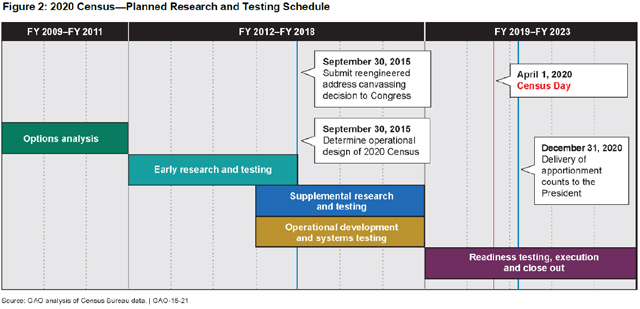Halfway to the 2020 Census
Today marks the halfway point between the last decennial census and the next one in 2020. The census is a massive undertaking, and its costs have increased by more than 500 percent over the past 50 years. The Census Bureau is considering new approaches to save money. However, mistakes from the last census—specifically the abandoned handheld data collection devices with $3 billion in cost overruns—loom large. Today’s WatchBlog explores the issues.
How to Stem Rising Costs?
The cost of counting each housing unit escalated from around $14 in 1970 to around $94 in 2010, in constant 2010 dollars, as shown below. To help address these rising costs, the Census Bureau is exploring ways to improve how it follows up with people who don’t initially respond. This is important because, in recent counts, about a third of households didn’t participate without an in-person visit. Historically, these visits have been the most costly part of the census.
(Excerpted from GAO-15-21)
Through its research and testing program—and with advice and recommendations from external stakeholders, including GAO—the Bureau has identified 4 ways to save money:
- Eliminate nationwide door-to-door operations to list all of the addresses in the country;
- Optimize self-response by communicating the importance of the 2020 Census to the public, and encouraging use of the Internet for follow-ups;
- Use other data sources such as information that households have already provided to the government to reduce the burden on the public and the need for follow-up; and
- Increase use of technology to more efficiently and effectively manage fieldwork.
Although these changes are promising, we’ve recommended improvements. For example, in October 2014 we found weaknesses in
- Identifying other data sources. The Bureau didn’t consistently document the cost and quality information that management would need to make data source decisions. The Bureau agreed with us and is working to improve.
- IT infrastructure for self-response. While the Bureau is working to develop an Internet response option, it hadn’t developed a reliable way to predict the Internet response rate or IT infrastructure needs.
At the end of this fiscal year, the Bureau will announce preliminary design decisions for the 2020 Census, as shown in the timeline below. To help Congress ensure it stays on track for the 2020 Census, we will continue to assess the Bureau’s decisions and plans.
(Excerpted from GAO-15-21)
- Questions on the content of this post? Contact Robert Goldenkoff at goldenkoffr@gov.
- Comments on GAO’s WatchBlog? Contact blog@gao.gov.







